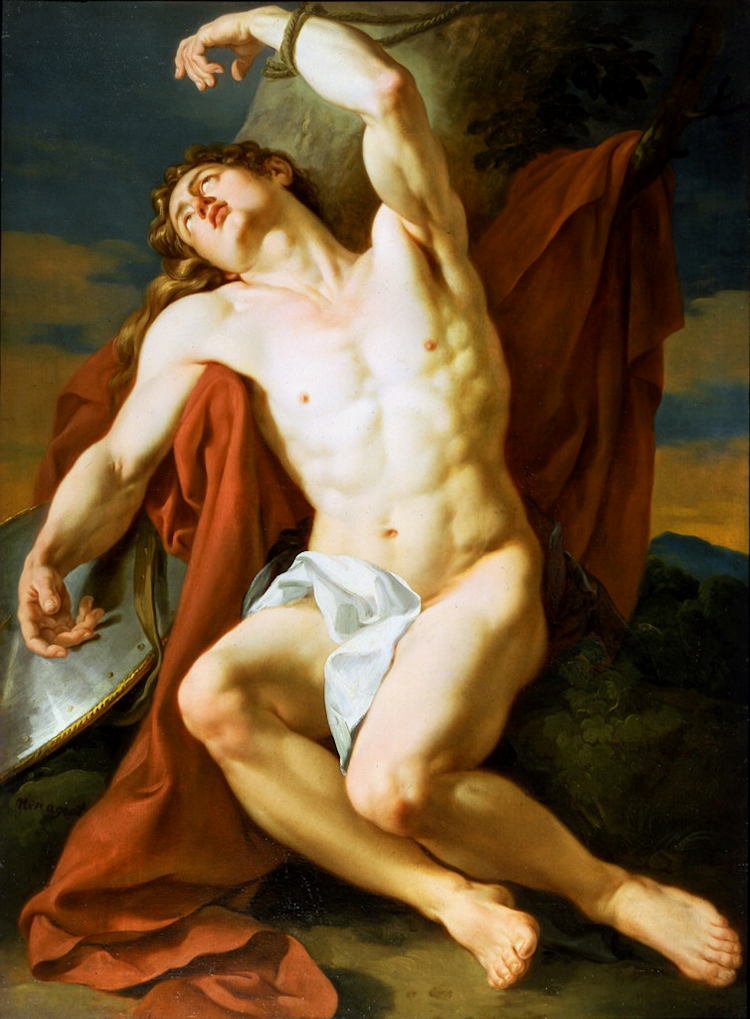 |
| Paul Delaroche, 1822. |
 |
| Salvator Rosa, 1650. |
When you go onto the internet looking for images of Saint Sebastian, expect to be sitting there a while. A long while. Other than Christ, himself, in the history of art I can think of no male religious figure who has been portrayed more frequently. (Maybe David or John the Baptist turn up more often?) Sometimes the compositions he inhabits are elaborate, with soldiers and landscapes, fluttering drapery, even a cherub or two. Sometimes Saint Irene and a maid are shown busy at work, tending to the devout pincushion. But most often just an underdressed young fellow, a few arrows, and bit of rope will suffice. And perhaps a tree.
 |
| Vicente López y Portaña, circa 1795-1800. |
 |
| Nicolas Régnier, 1625.(Régnier and his studio made rather a career of painting St. Sebastians.) |
But why is he everywhere? He's not a particularly
useful saint; he doesn't actually serve much biblical purpose. The only things he really has to recommend him are high drama and pulchritude. A whole lot of male pulchritude. I expect those qualities - particularly the latter - are what has kept him in such frequent rotation. At any rate, here is a selection of "saintly" torsos. I haven't included all that many that are very well known, or ones that I've already included elsewhere on this blog. This is just a tiny sampling of the apparently
infinite moods of Sebastians: calm and writhing, pretty and ugly, silly and tragic, gross and lyrical.
 |
| San Sebastiano nel bosco di Calvenzano, d'après Guido Reni, by Luigi Ontani, 1970. |
 |
| Augustin Van den Berghe, 1777. |
 |
| Bernardo Strozzi, circa 1631-36. |
 |
| F. Holland Day, 1907. |
 |
| Master of the Virgo inter Virgines, 1480. |
 |
| Circle of Nicolas Régnier, first half of the seventeenth century. |
 |
| Pietro Perugino, circa 1493-4. |
 |
| Hendrick ter Brugghen, 1625. |
 |
| Giovanni Colacicchi, 1930s. (Study for the following painting.) |
 |
| Giovanni Colacicchi, 1930s. |
 |
| Jean-Baptiste-Camille Corot, 1851-73. |
 |
| François-Guillaume Ménageot, 1803. |
 |
| François-Xavier Fabre, 1789. |
 |
| The Master MZ, circa 1500-10. |
 |
| Greg Semu, 2014. |
 |
| Marco Antonio Bassetti, circa 1620. |
 |
| Gustave Moreau, circa 1870. |
 |
| Master of the Holy Kinship, circa 1493-94. |
 |
| Cornelis van Haarlem, circa 1591. |
 |
| Anthony Gayton, 2004. |
 |
| Honoré Daumier, circa 1849-50. |
 |
| José de Ribera, 1636. |
 |
| Frans Badens, between 1600-18, |
 |
| Alexandra Hiller, 2000. (?) |
 |
| Dosso Dossi, 1526. |
 |
| Antonello da Messina, 1477. |
 |
| Ed Fury, Athletic Model Guild, circa 1950s. |
 |
| Mattia Preti, circa 1660. |
 |
| Jean-Baptiste-Camille Corot, 1850. |
 |
| Simon Vouet, 1621-2. |
 |
| Kieran Keat, circa 2010. |
 |
| Nicolas Régnier, circa 1620. |







































Fabulous! And as always, an introduction to the unexpected in this genre. A Sunday morning treat.. though I did say Ouch once or twice!
ReplyDeleteThank you, sir! Really, the examples are endless, the "gathering" exhausting; I just couldn't find any sort of end to the thing ; ) There's a part two coming up in a few weeks, and just as long....
DeleteLooking forward to part 2, though how you can top this post is beyond me!
DeleteAnd as an aside, I cannot help feeling that whenever Saint Sebastian is depicted, kitsch or camp is lurking just around the corner. Of course there are notable exceptions. The Antonello da Messina is sublime in its direct uncompromising way.
Most of your examples show pain, faith in God, resignation and support for other Christians in hiding. The Salvator Rosa, Strozzi and Preti paintings (all mid 17th century) are particularly sensitive.
ReplyDeleteBut Master of the Virgo inter Virgines, 1480 reminds me of a school master giving a severe scalding to a naughty pupil. Making Sebastian the patron saint of archers is a bit gross.